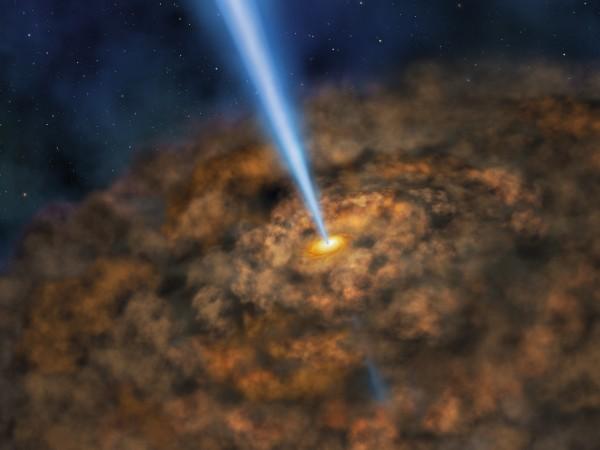
A black hole shredding a star passing by and eating it has opened up deep insights into the workings of these massive celestial objects and their influence on the evolution of whole galaxies.
When matter is devoured by a black hole, it spits out jet streams of radiation, radio waves, and X-rays. Researchers have now found that when a black hole 300 million light years away ate a star, the X-ray signals repeated itself almost perfectly in the radio wavelengths that followed it nearly two weeks later. This "radio echo" most likely emerged from high energy particles streaming out from inside the black hole, reports Space.com.
A black hole, while never directly observed till date, is described as points in the universe where mass is incredibly high and density is infinite, which in turn means it has infinite gravity. Black holes are formed when a star collapses on itself by the end of its life cycle. After black holes are formed, they normally begin to get bigger and bigger by devouring anything in their path, according to the report.
The gravity from a black hole is so great that it tugs, stretches, and eventually crumbles celestial bodies, sometimes as large as stars. The shredded material then settles into a large swirl of gas and dust around the black hole. This region is called the accretion disk and it works like a funnel, constantly feeding it, reports NASA.
This then causes jets of radiation and X-rays to spew out from the black hole. It was one of these outbursts of radiation after a star feeding process that Las Cumbres Observatory's All-sky Automated Survey for Supernovae- a network of robotic telescopes from around the world, was able to capture in 2014.
This event was named ASASSN-14li, according to the Space.com report, and several telescopes immediately were turned to track the tidal disruption flare –powerful electromagnetic energy that explodes outward when a star gets eaten.
After a thorough analysis of data, researchers Dheeraj Pasham, a researcher at the Massachusetts Institute of Technology, and Sjoert van Velzen, of Johns Hopkins University reportedly found a pattern in the radio wavelengths that matched up almost exactly to the X-ray signal. It was a 90 percent match. "This is telling us the black hole feeding rate is controlling the strength of the jet it produces," Pasham said in a statement.
"A well-fed black hole produces a strong jet, while a malnourished black hole produces a weak jet or no jet at all. This is the first time we've seen a jet that's controlled by a feeding supermassive black hole," he explained.

















